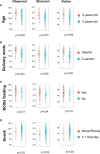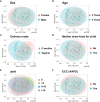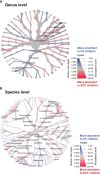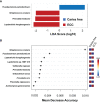Multimodal Data Integration Reveals Mode of Delivery and Snack Consumption Outrank Salivary Microbiome in Association With Caries Outcome in Thai Children
- PMID: 35677657
- PMCID: PMC9168266
- DOI: 10.3389/fcimb.2022.881899
Multimodal Data Integration Reveals Mode of Delivery and Snack Consumption Outrank Salivary Microbiome in Association With Caries Outcome in Thai Children
Abstract
Early childhood caries (ECC) is not only the most common chronic childhood disease but also disproportionately affects underserved populations. Of those, children living in Thailand have been found to have high rates of ECC and severe ECC. Frequently, the cause of ECC is blamed on a handful of cariogenic organisms, such as Streptococcus mutans and Streptococcus sobrinus. However, ECC is a multifactorial disease that results from an ecological shift in the oral cavity from a neutral pH (~7.5) to an acidic pH (<5.5) environment influenced by the host individual's biological, socio-behavioral, and lifestyle factors. Currently, there is a lack of understanding of how risk factors at various levels influence the oral health of children at risk. We applied a statistical machine learning approach for multimodal data integration (parallel and hierarchical) to identify caries-related multiplatform factors in a large cohort of mother-child dyads living in Chiang Mai, Thailand (N=177). Whole saliva (1 mL) was collected from each individual for DNA extraction and 16S rRNA sequencing. A set of maternal and early childhood factors were included in the data analysis. Significantly, vaginal delivery, preterm birth, and frequent sugary snacking were found to increase the risk for ECC. The salivary microbial diversity was significantly different in children with ECC or without ECC. Results of linear discriminant analysis effect size (LEfSe) analysis of the microbial community demonstrated that S. mutans, Prevotella histicola, and Leptotrichia hongkongensis were significantly enriched in ECC children. Whereas Fusobacterium periodonticum was less abundant among caries-free children, suggesting its potential to be a candidate biomarker for good oral health. Based on the multimodal data integration and statistical machine learning models, the study revealed that the mode of delivery and snack consumption outrank salivary microbiome in predicting ECC in Thai children. The biological and behavioral factors may play significant roles in the microbial pathobiology of ECC and warrant further investigation.
Keywords: diet; early childhood caries; machine learning; multimodal analysis; oral microbiome; saliva.
Copyright © 2022 Wu, Xiao, Manning, Saraithong, Pattanaporn, Paster, Chen, Vasani, Gilbert, Zeng and Li.
Conflict of interest statement
The authors declare that the research was conducted in the absence of any commercial or financial relationships that could be construed as a potential conflict of interest.
Figures







Similar articles
-
Comparison of the salivary and dentinal microbiome of children with severe-early childhood caries to the salivary microbiome of caries-free children.BMC Oral Health. 2019 Jan 14;19(1):13. doi: 10.1186/s12903-018-0693-1. BMC Oral Health. 2019. PMID: 30642327 Free PMC article.
-
Evaluating the ecological hypothesis: early life salivary microbiome assembly predicts dental caries in a longitudinal case-control study.Microbiome. 2022 Dec 26;10(1):240. doi: 10.1186/s40168-022-01442-5. Microbiome. 2022. PMID: 36567334 Free PMC article.
-
Inter-kingdom interactions and environmental influences on the oral microbiome in severe early childhood caries.Microbiol Spectr. 2025 Jun 3;13(6):e0251824. doi: 10.1128/spectrum.02518-24. Epub 2025 Apr 15. Microbiol Spectr. 2025. PMID: 40243315 Free PMC article.
-
Salivary proteins and microbiota as biomarkers for early childhood caries risk assessment.Int J Oral Sci. 2017 Nov 10;9(11):e1. doi: 10.1038/ijos.2017.35. Int J Oral Sci. 2017. PMID: 29125139 Free PMC article. Review.
-
Case definition, aetiology and risk assessment of early childhood caries (ECC): a revisited review.Eur Arch Paediatr Dent. 2008 Sep;9(3):114-25. doi: 10.1007/BF03262622. Eur Arch Paediatr Dent. 2008. PMID: 18793593 Review.
Cited by
-
Distinct mucosal and systemic immunological characteristics in transgender women potentially relating to HIV acquisition.JCI Insight. 2023 Aug 22;8(16):e169272. doi: 10.1172/jci.insight.169272. JCI Insight. 2023. PMID: 37432754 Free PMC article.
-
The association between mode of childbirth delivery and early childhood caries: A comprehensive systematic review and meta-analysis.PLoS One. 2024 Sep 26;19(9):e0310405. doi: 10.1371/journal.pone.0310405. eCollection 2024. PLoS One. 2024. PMID: 39325830 Free PMC article.
-
Novel Clustering Methods Identified Three Caries Status-Related Clusters Based on Oral Microbiome in Thai Mother-Child Dyads.Genes (Basel). 2023 Mar 3;14(3):641. doi: 10.3390/genes14030641. Genes (Basel). 2023. PMID: 36980913 Free PMC article.
-
Dynamics of oral microbiome acquisition in healthy infants: A pilot study.Front Oral Health. 2023 Mar 30;4:1152601. doi: 10.3389/froh.2023.1152601. eCollection 2023. Front Oral Health. 2023. PMID: 37065420 Free PMC article.
-
Interkingdom assemblages in human saliva display group-level surface mobility and disease-promoting emergent functions.Proc Natl Acad Sci U S A. 2022 Oct 11;119(41):e2209699119. doi: 10.1073/pnas.2209699119. Epub 2022 Oct 3. Proc Natl Acad Sci U S A. 2022. PMID: 36191236 Free PMC article.
References
-
- American Academy of Pediatric Dentistry . (2020). Policy on Early Childhood Caries (ECC): Classifications, Consequences, and Preventive Strategies. The Reference Manual of Pediatric Dentistry. (Chicago, Ill.: American Academy of Pediatric Dentistry; ), 79–81. Available at: https://www.aapd.org/media/policies_guidelines/p_eccclassifications.pdf.
Publication types
MeSH terms
Substances
Grants and funding
LinkOut - more resources
Full Text Sources
Medical

